Ayutthaya, Thailand: A Comprehensive Travel Guide

Table of Contents
- Ayutthaya’s History and Origins
- Getting to Ayutthaya from Bangkok
- Getting Around Ayutthaya
- Best Ayutthaya Tours and Activities
- Major Temples and Ruins
- Sample Itineraries
- Nearby Attractions and Side Trips
- Top Hotels and Budget Stays in Ayutthaya
- Best Local Food and Top Restaurants in Ayutthaya
- Costs and Budget Tips
- When to Go (Weather and Seasons)
- FAQs and Common Mistakes
- Practical Tips and Etiquette
- Conclusion and Final Thoughts
Ayutthaya’s History and Origins
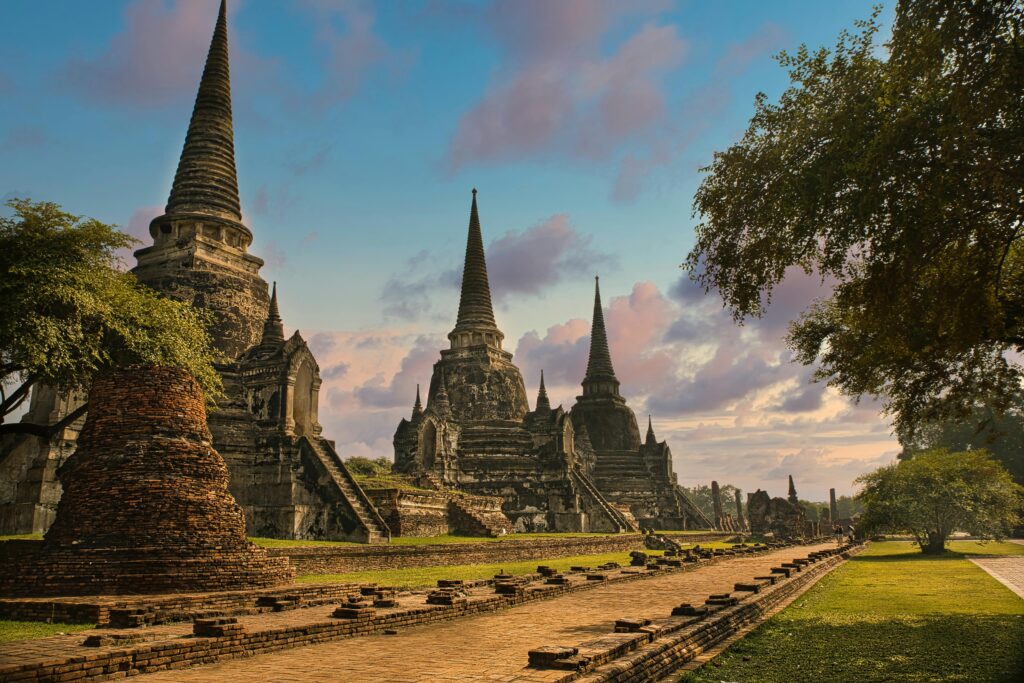
The famous Buddha head entwined in tree roots at Wat Mahathat, Ayutthaya.
Ayutthaya travel guide: Founded around 1350 by King Ramathibodi I, Ayutthaya became the second capital of the Siamese Kingdom after Sukhothai. For over four centuries (1350–1767), it thrived as a major hub of commerce, attracting traders from China, Persia, and Europe. By the 1700s, Ayutthaya was one of the world’s largest and wealthiest cities, with a population exceeding a million and hundreds of gilded temples. Its strategic location made it a key player in East-West trade, with separate foreign quarters for Dutch, French, Persian, Chinese, and Japanese merchants, reflecting its status as a global trading center.
However, in 1767, Ayutthaya’s prosperity came to a violent end. A Burmese army besieged the city, leaving it in ruins after a prolonged siege. Palaces and temples were destroyed, treasures looted, and countless Buddha statues were decapitated to demoralize the Siamese. The once-great capital was abandoned to the jungle, but its surviving stone ruins – elegant prang towers and colossal stupas – still testify to its past splendor. Today, Ayutthaya’s archaeological park is a UNESCO World Heritage Site, inviting travelers to explore its evocative ruins and reflect on its turbulent history.
Despite this destruction, Ayutthaya’s influence lives on in Thai culture and architecture. The new Siamese capital was later established in Bangkok, but the artistic styles, city planning, and cultural innovations of Ayutthaya continued to shape the Rattanakosin (Bangkok) era. Visitors today can walk among these ruins, imagining the city’s former glory as a center of art, culture, and diplomacy.
Key Dates:
- 1350: Ayutthaya founded by King Ramathibodi I.
- 1700s: Peak of Ayutthaya’s power and wealth.
- 1767: Fall of Ayutthaya to the Burmese army.
Getting to Ayutthaya from Bangkok
Ayutthaya lies about 80–85 km north of Bangkok, making it a convenient destination for a day trip or overnight excursion. Here are the main ways to get there:
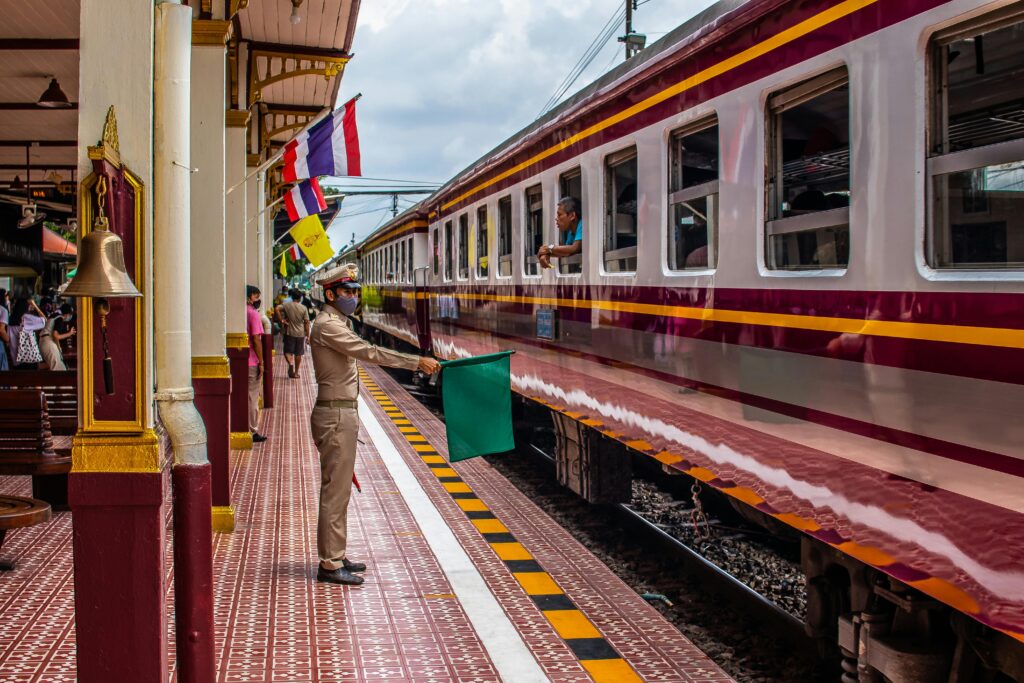
By Train
Trains depart frequently from Hua Lamphong or Krung Thep Aphiwat (Bangkok Central) station. The journey takes about 1.5 to 2 hours, depending on the train. This is one of the most budget-friendly options, with third-class tickets priced at just ฿15–฿20 (under $1) one-way. Trains are basic, with open windows and fans, but offer a glimpse of the Thai countryside. For more comfort, opt for 2nd-class A/C (around ฿240) or 1st-class on select trains. No advance booking is needed for 3rd class, but you can use services like 12Go for reserved seats.
By Minivan or Bus
Minivans to Ayutthaya depart from Mo Chit Northern Bus Terminal throughout the day. The ride takes about 1–1.5 hours (depending on traffic) and costs roughly ฿60–฿100 per person. These air-conditioned vans are faster than the train and drop you near Ayutthaya’s center. Alternatively, large buses run from the same terminal for a similar price but may take a bit longer due to stops. Tickets are usually bought on the spot, but some agencies offer package tours including guided visits to Ayutthaya’s main sites.
By Car or Taxi
Hiring a private taxi or using a Grab ride-share is the fastest and most direct option. The trip takes around 1 hour 15 minutes in good traffic, with fares ranging from ฿800–฿1200 (or about $30 via Grab). This can be a good choice for groups or those seeking comfort. Some drivers offer round-trip services for an additional fee.
By Boat
For a scenic alternative, consider traveling by river. Several companies offer boat trips between Bangkok and Ayutthaya, often as part of a day tour. A popular option is to take a bus to Ayutthaya in the morning and return by river cruise in the afternoon, enjoying lunch on board. The boat ride takes about 3 hours and costs ฿1000–฿2000+ per person. This route offers a unique perspective on the Chao Phraya River and the historic trade routes of Ayutthaya’s past.
Tips for Train Travelers:
- Ayutthaya’s railway station is across the river from the old city. Upon arrival, take a short walk to the ferry pier for a ฿5–฿10 boat ride across the river, or hire a tuk-tuk to your destination.
- If you plan to return to Bangkok the same day, check the train schedule in advance. The last ordinary train back to Bangkok usually departs around 6–7 PM, costing around ฿15.
Getting Around Ayutthaya

Once in Ayutthaya, the historical attractions are spread out across an island formed by encircling rivers. While the city is relatively compact, it can be challenging to cover entirely on foot in the tropical heat. Here are the main transportation options within Ayutthaya:
Bicycle
Renting a bicycle is a popular way to explore the ruins. Many guesthouses and rental shops offer bikes for about ฿50–฿70 per day. Bicycles provide flexibility and freedom, allowing you to move at your own pace. Distances between major temples are typically just a few kilometers, but be prepared for heat and uneven roads. Always lock your bike when visiting sites and be cautious on busier roads. Keep in mind that Thais drive on the left.
Tuk-Tuk
Ayutthaya’s tuk-tuks are larger and more robust than those in Bangkok. They can be hired for around ฿200 per hour (negotiable) for temple tours. For example, a 3–4 hour tour might cost ฿600–฿800. Be sure to agree on the price and the route before starting your trip. Avoid drivers at the train station, as they often charge higher rates. It’s better to walk a few minutes away or arrange a ride through your hotel for a fair deal.
Motorbike or Scooter
For those comfortable on two wheels, motorbikes and scooters can be rented for ฿250–฿400 per day. This option offers more speed and independence than bicycles or tuk-tuks, but requires an international driving permit. Helmets are mandatory by law, and it’s wise to double-check the bike’s condition before setting off. Note that some rental shops may hold your passport as a deposit.
Walking
While some central ruins are within walking distance (e.g., Wat Mahathat, Wat Ratchaburana, Wat Phra Si Sanphet), the midday heat can be intense. If you choose to walk, start early or late, carry water, and wear sun protection. Some sites, like Wat Chaiwatthanaram and Wat Yai Chai Mongkhon, are further out and better reached by bike or tuk-tuk.
Guided Tours & Boat Tours
Guided tours are a great way to learn about the history of Ayutthaya. Local guides can provide context and stories that you might miss on your own. Evening boat tours around the island are also popular, with small longtail boats available near Wat Phanan Choeng or the Chao Phraya River pier. A one-hour boat trip costs around ฿500 (negotiable) and offers a unique perspective on the city’s waterways.
Tips for Exploring Ayutthaya:
- Many accommodations offer free bikes or can help arrange transport.
- Start early to avoid the heat and crowds.
- Plan your route logically to avoid backtracking.
Best Ayutthaya Tours and Activities

Ayutthaya offers a wide range of tours and activities, from guided temple walks to scenic river cruises. Here are some popular options:
Guided Temple Tours
- Discover Ayutthaya’s rich history with a full-day guided tour, including visits to major temples like Wat Mahathat, Wat Phra Sri Sanphet, and Wat Chaiwatthanaram.
- Many tours include round-trip transportation from Bangkok and a traditional Thai lunch.
Bicycle Tours
- Explore Ayutthaya’s historical park at your own pace on a bicycle. This is a great way to see the temples up close and navigate the smaller lanes that larger vehicles can’t access.
- Half-day and full-day bike tours are available, often including local guides who share insights about the city’s history.
Boat Tours
- Enjoy a scenic sunset cruise around Ayutthaya’s island, stopping at riverside temples and enjoying views of the ancient city from the water.
- Evening boat tours are a relaxing way to experience Ayutthaya’s charm, often including dinner on board.
Elephant Experiences
- Interact with retired elephants at a sanctuary near Ayutthaya. Activities may include feeding, bathing, and walking with the elephants in a natural setting.
- These experiences offer a more ethical way to connect with Thailand’s iconic animals.
Major Temples and Ruins
Ayutthaya’s main appeal lies in its array of ancient temple ruins, each with its own unique history and architectural style. Here are the must-see sites:
Wat Mahathat

- One of Ayutthaya’s most iconic temples, known for the Buddha head entwined in tree roots.
- Believed to be among the city’s oldest temples, possibly built in the late 14th century by King Borommaracha I.
- Served as the royal monastery and religious center of Ayutthaya.
- Famous for its collapsed central prang and numerous sandstone Buddha statues.
- Entry Fee: ฿50
Wat Phra Si Sanphet
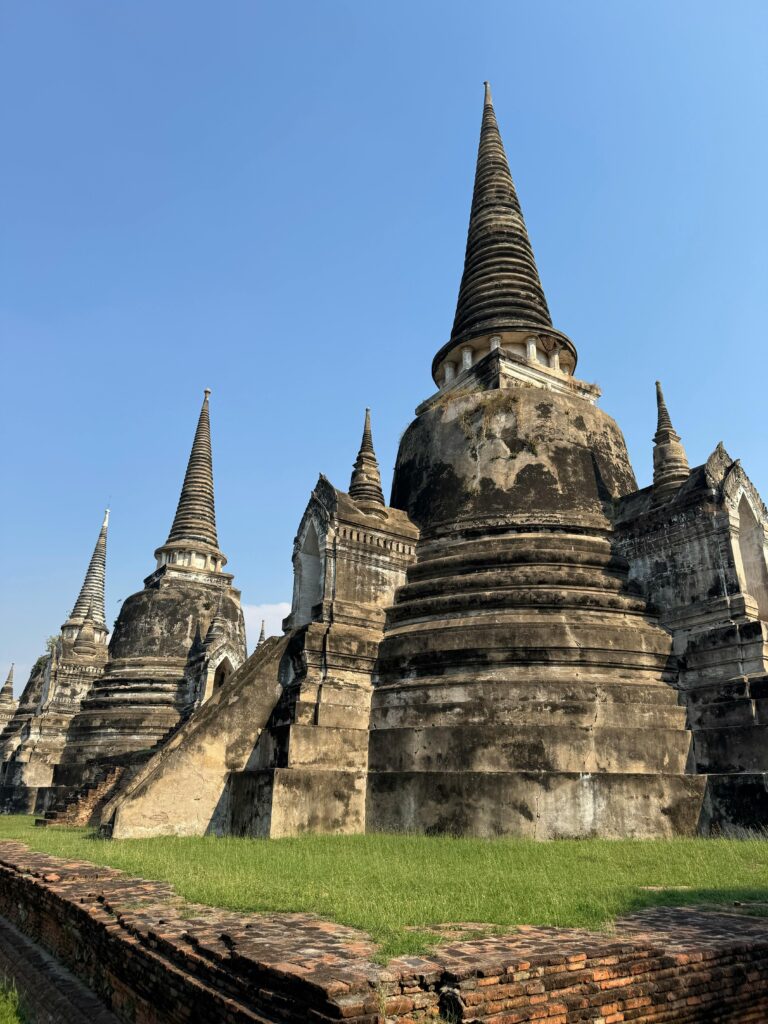
- The holiest temple of the Ayutthaya Royal Palace, used exclusively by Ayutthaya’s kings for ceremonies.
- Known for its three large bell-shaped chedi, restored to their full form.
- These chedis enshrine the ashes of three 15th-century kings.
- Once housed a 16-meter tall gilded Buddha, Phra Si Sanphet, which was covered in gold before being destroyed by the Burmese in 1767.
- Entry Fee: ฿50
Wat Ratchaburana

- Built in 1424 by King Borommarachathirat II at the site where his two elder brothers died in a duel for the throne.
- Known for its richly carved central prang, which is one of the best-preserved in Ayutthaya.
- Treasure troves of gold artifacts were discovered in its crypt in the 1950s, now displayed in the Chao Sam Phraya National Museum.
- Entry Fee: ฿50 (often included in combined tickets)
Wat Chaiwatthanaram
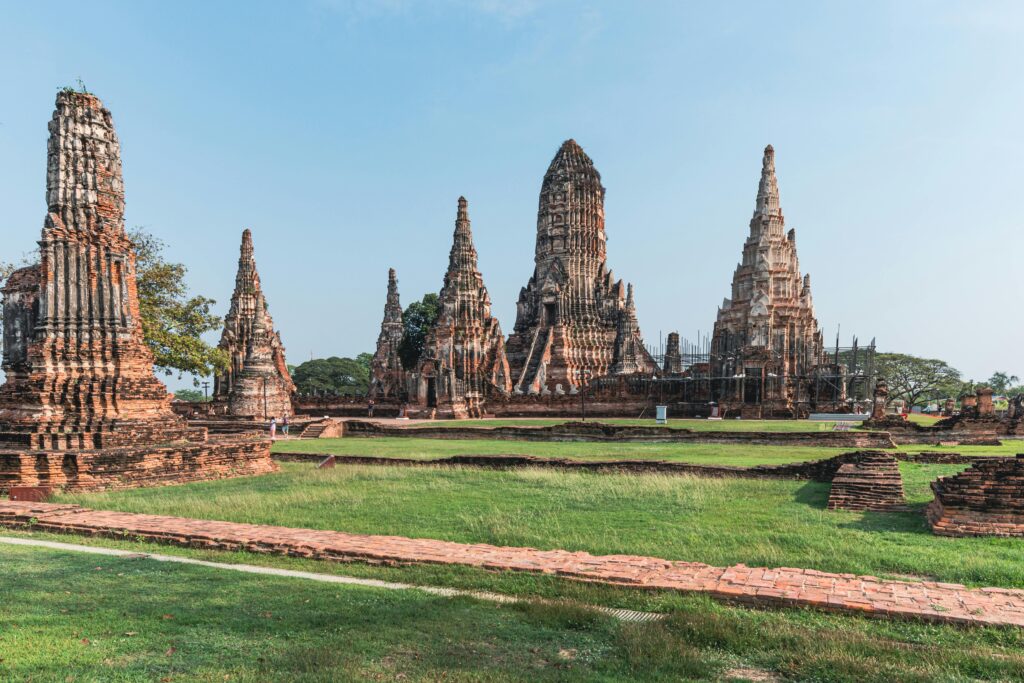
- Built in 1630 by King Prasat Thong to honor his mother and commemorate a victorious campaign.
- Reflects strong Khmer architectural influence, similar to Angkor Wat.
- Known for its 35-meter high central prang and rectangular gallery.
- Best visited at sunset for dramatic views of the red brick structures.
- Entry Fee: ฿50 (closes by 6:00 PM)
Wat Yai Chai Mongkhon
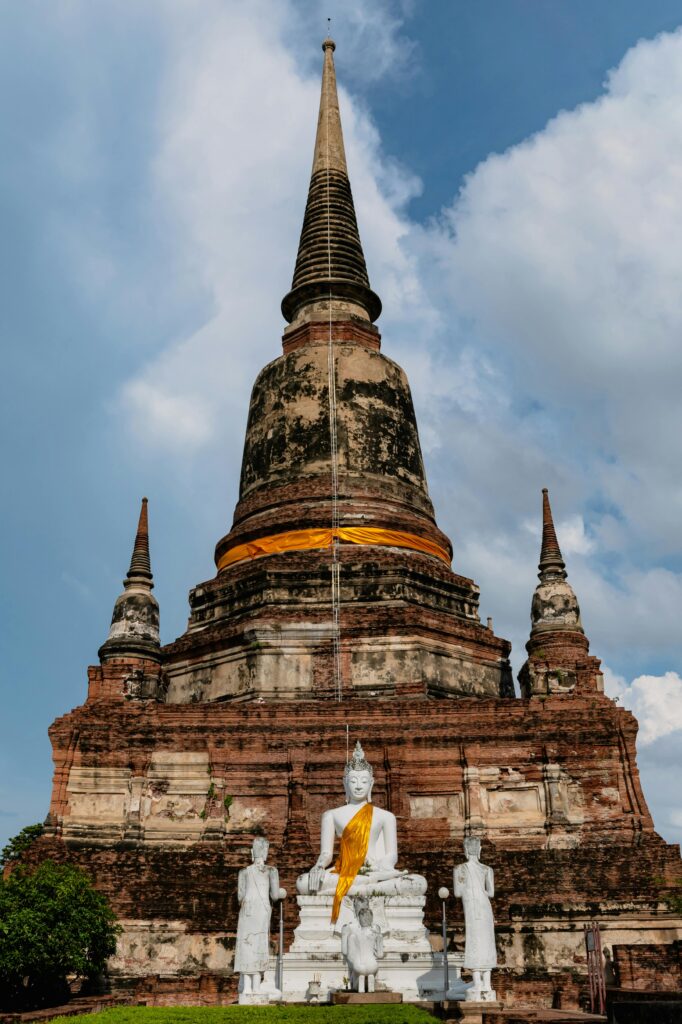
- Known for its massive chedi and giant reclining Buddha draped in orange cloth.
- Originally built in 1357 and later expanded by King Naresuan to commemorate a victory over the Burmese.
- The chedi can be climbed for panoramic views of the monastery grounds.
- Entry Fee: ฿20
Other Notable Sites
- Wat Phanan Choeng: One of the oldest active temples in Ayutthaya, housing a 19-meter tall gilded Buddha from 1334.
- Wat Thammikarat: Known for its weathered lion statues and large bronze Buddha head.
- Wat Lokayasutharam: Famous for its giant Reclining Buddha, 37 meters long, lying outdoors.
- Ayutthaya Historical Study Centre & Chao Sam Phraya Museum: Great for understanding Ayutthaya’s history through dioramas and artifacts, including treasures from Wat Ratchaburana.
Tip: If you plan to visit many sites, consider buying a combined ticket for ฿220 that covers six major temples, including Wat Mahathat, Wat Ratchaburana, Wat Phra Si Sanphet, Wat Phra Ram, Wat Chaiwatthanaram, and Wat Maheyong.
Sample Itineraries

Whether you’re visiting for a day or staying longer, here are some suggested itineraries to make the most of your time in Ayutthaya:
1 Day in Ayutthaya (Day Trip)
Morning:
- Arrive by train or van around 9 AM.
- Visit Wat Phra Mahathat (Buddha head in tree roots) and Wat Ratchaburana.
- Walk to Wat Phra Si Sanphet and the Royal Palace ruins.
Lunch:
- Quick stop at a local restaurant or market for a break.
Afternoon:
- Cross the river to Wat Yai Chai Mongkhon.
- Continue to Wat Chaiwatthanaram on the west bank for late afternoon photos.
Evening:
- Return to Bangkok by train or bus. If you have time, consider an early dinner by the river.
2 Days in Ayutthaya
Day 1:
- Morning: Explore Wat Mahathat, Wat Ratchaburana, and Wat Thammikarat.
- Afternoon: Visit Wat Phra Si Sanphet and the nearby Chao Sam Phraya Museum.
- Sunset: Wat Chaiwatthanaram.
- Evening: Night market or riverside dinner.
Day 2:
- Morning: Sunrise at Wat Yai Chai Mongkhon.
- Midday: Visit Wat Phanan Choeng and other lesser-known ruins.
- Afternoon: Bicycle ride around the island or visit Bang Pa-In Palace.
- Evening: Sunset boat tour around the island (optional).
3 Days in Ayutthaya
Days 1-2:
- Follow the two-day itinerary above.
Day 3:
- Optional side trip to Lopburi for the Monkey Temple (Prang Sam Yod) and King Narai’s Palace.
- Alternatively, explore less-visited ruins or take a Thai cooking class.
- End the day with a relaxed dinner in Ayutthaya.
Tips:
- Start early to avoid the heat.
- Rent a bicycle for flexibility.
- Dress appropriately for temple visits (knees and shoulders covered).
Nearby Attractions and Side Trips
Beyond the central ruins, Ayutthaya province offers several other attractions that make for enjoyable side trips or half-day excursions:
Bang Pa-In Royal Palace
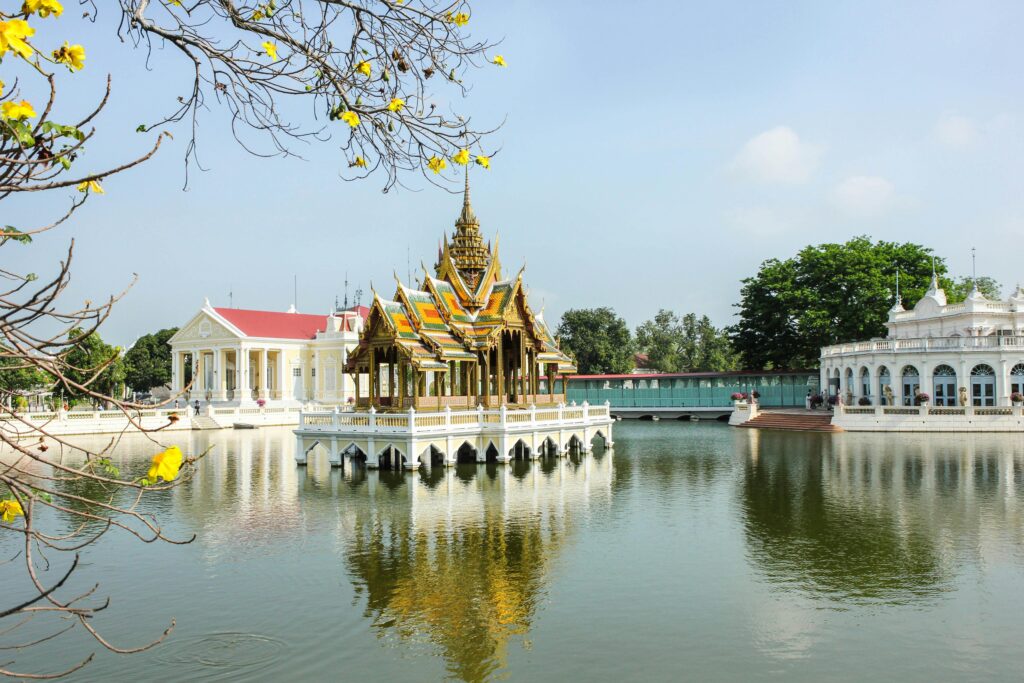
- Located about 20 km south of Ayutthaya, this Summer Palace was originally established in the 17th century and later restored by King Rama IV and King Rama V in the 19th century.
- The grounds feature a mix of Thai, Chinese, and European architecture, including the iconic Aisawan Thiphya-Art Pavilion and the Phra Thinang Wehart Chamrun (Chinese Palace).
- Entry Fee: ฿100
- Getting there: Accessible by train (some stop at Bang Pa-In station), taxi, or guided tour.
Wat Niwet Thammaprawat
- Located just across the river from Bang Pa-In Palace, this unique temple was built in 1878 in Gothic Revival style, resembling a European church.
- Features stained-glass windows and a chapel that looks like a cathedral inside, but with a Buddha on the altar.
- Accessible by a small cable-car ferry.
- Worth a quick visit if you’re already at Bang Pa-In.
Portuguese, Dutch, and Japanese Settlements
- In the 16th–18th centuries, Ayutthaya allocated specific areas for foreign traders.
- Portuguese Settlement: Features the ruins of the Dominican Church of San Pedro and a small museum displaying relics of the Portuguese community.
- Dutch Settlement (Baan Hollanda): Now a museum showcasing the history of the Dutch East India Company in Ayutthaya.
- Japanese Village: Commemorates the Japanese traders and mercenaries who lived in Ayutthaya, with a small museum and garden.
- These sites are a bit spread out, so consider hiring a tuk-tuk or bicycle for easier access.
Ayothaya Floating Market (and Elephant Village)
- A recreated traditional floating market northeast of the city center.
- The market features food stalls, souvenir shops, and daily cultural performances.
- Note: Some visitors find it a bit touristy, and the adjacent elephant camp raises ethical concerns due to animal welfare issues.
Elephant Kraal Pavilion
- A historic site north of the city where wild elephants were once captured and trained.
- Features a large stockade made of teak logs, once used for royal ceremonies.
- Can be combined with a visit to Wat Phu Khao Thong (a tall white stupa nearby).
- Entry Fee: Free
Other Ideas:
– Lopburi: Known for its monkey-inhabited Khmer temple (Prang Sam Yod) and King Narai’s Palace. About 1 hour by train from Ayutthaya.
– Saraburi: Visit Wat Phra Phutthabat to see the sacred Buddha footprint.
Tips:
- Start early to avoid crowds.
- Dress appropriately for temple visits.
- Plan your route to avoid backtracking.
Top Hotels and Budget Stays in Ayutthaya
Ayutthaya offers a range of accommodations to suit all budgets, from backpacker hostels to boutique riverside resorts. Many properties are located on or near the historical island, which is convenient for sightseeing. Here’s an overview:
Budget Stays (฿300–฿800 / $10–$25 per night)
- San Sook Hostel: Basic dorms and private rooms, free Wi-Fi, and friendly atmosphere.
- Zee Thai Hostel: Popular with backpackers, close to the historical park.
- Baan Are Gong Riverside Homestay: Traditional teak house near the train station, convenient for early arrivals.
- Baan Penny Ayutthaya: Private bungalows with A/C, Wi-Fi, hot showers, and free bike rentals.
Mid-Range Comfort (฿1,500–฿3,000 / $45–$90 per night)
- Baan Thai House: Lakeside property with Thai-style villas, pool, and gardens.
- Ayothaya Hotel: Larger hotel with full facilities, including a pool and restaurant.
- Sala Ayutthaya: Known for its modern design, riverside location, and great views of Wat Phutthaisawan.
High-End & Boutique Luxury (฿4,000+ / $120+ per night)
- Baan Pomphet: Stylish 4-star hotel with red-brick architecture and riverside views.
- Pludhaya Resort & Spa: Traditional teak villas in a garden setting, with a spa and private atmosphere.
Unique Stays
- Homestays: Stay with local families for a more authentic experience.
- Houseboats: Spend a night on the river for a unique perspective of Ayutthaya.
Tips:
- Staying on the historical island is most convenient for sightseeing.
- Consider the Tha Wa Su Kri neighborhood for easy access to temples and cafes.
- Book ahead for weekends and Thai holidays, as accommodations fill up quickly.
Best Local Food and Top Restaurants in Ayutthaya

Ayutthaya may not be as famous as Bangkok or Chiang Mai for dining, but it has its own culinary highlights and plenty of delicious, affordable food options. Here are some must-try dishes and popular dining spots:
Local Specialties
- Boat Noodles (kuay teow rua) – Small bowls of rice noodles in a rich, often spicy broth, traditionally served from boats. Typically topped with slices of meat, meatballs, bean sprouts, and herbs. Portions are small, so locals often order 2–5 bowls at a time. Expect to pay around ฿20 per bowl.
- Giant River Prawns – Grilled freshwater prawns, often 150–200g each, served with spicy seafood sauce. Market price, typically ฿500+ per set.
Street Food and Night Markets
- Bang Lan Night Market – Opens after 5 PM, offering a wide range of Thai street food, from grilled meats and soups to sweets like Khanom Babin (coconut pancakes). Most dishes ฿30–฿60.
- Krungsri Walking Street Night Market – Held on weekends (Fri-Sun) near Wat Phra Ram. Known for traditional performances and street eats like Roti Sai Mai (Thai cotton candy wrapped in fresh roti).
Restaurants and Cafes
- The Coffee Old City – Known for Thai and Western dishes in a cozy setting.
- Malakor Cafe – Offers Thai food, vegetarian options, and a view of a lit chedi at night.
- Baan Pomphet Restaurant – Upscale riverside dining with fresh seafood and traditional Thai dishes.
- The Summer House Cafe – Riverside garden setting, great for sunsets.
Nightlife
- Ayutthaya is not a party town, but there are a few backpacker-friendly bars around Naresuan Road. Try Tony’s Place or Jazz Bar for a casual beer.
Tips:
- Street stalls may have little or no English, but pointing and smiles go a long way.
- Stay hydrated – buy cold drinks or fresh coconuts from vendors near major temples.
- Many morning markets wind down by late morning, so visit early if you want authentic local breakfast.
Costs and Budget Tips
Traveling in Ayutthaya is generally affordable. Here’s a breakdown of common costs and some tips to save money:
Transportation
- Train from Bangkok: ฿20 for third class, ฿300+ for air-conditioned second class.
- Minivan: ฿70–฿100 per person.
- Bicycle Rental: ฿50 per day.
- Tuk-Tuk: ฿200 for short trips, ฿800 for a half day.
- Private Car from Bangkok: ฿1000 each way.
Accommodation
- Budget Stays: Dorms and basic guesthouses ฿300–฿600 per night.
- Mid-Range Hotels: ฿1500–฿2500 per night, often with more amenities.
- Top-End Options: Typically ฿4000+ per night, but still more affordable than Bangkok.
Sightseeing
- Most temple ruins charge ฿50 for entrance.
- Combined Ticket: ฿220 for 6 major temples (must be used within the same day).
- National Museum: ฿150 per person.
- Some smaller temples are free or accept donations.
Food
- Street Food: ฿30–฿80 per meal.
- Market Meals: Under ฿100 for a filling meal.
- Western Dishes: ฿150–฿300 in cafes.
- River Prawns: ฿500+ per set.
Money Matters
- Local currency is Thai Baht (THB).
- ATMs available, but ฿220 withdrawal fee for foreign cards.
- Cash is still preferred at street stalls and smaller guesthouses.
Budget Tips
- Combined Ticket: Save money by buying the ฿220 combo pass for 6 major temples.
- Free Sites: Not all attractions have entry fees – Wat Lokayasutharam (reclining Buddha) is free, and many active temples only accept donations.
- Food Savings: Street food is much cheaper than restaurants. Stock up at morning markets for budget meals.
- Share Transport: If you’re traveling solo, find others to share tuk-tuk costs.
- Avoiding Scams: Walk a bit away from the train station for more reasonable tuk-tuk rates.
- Student Discounts: Some sites offer discounted entry for students with ID.
Sample Daily Budgets:
– Budget Traveler: ฿1000 ($30) – Hostel, bike rental, street food, basic temple fees.
– Mid-Range Traveler: ฿2000–฿3000 ($60–$90) – Mid-range hotel, restaurant meals, some tuk-tuk use.
When to Go (Weather and Seasons)
Ayutthaya’s weather follows the typical central Thailand tropical pattern, with a cool season, hot season, and rainy season. You can visit year-round, but each season has its pros and cons:
Cool Season (November to February)
- Temperature: 20–30°C, cooler mornings and evenings.
- Weather: Dry and comfortable, ideal for cycling and full-day sightseeing.
- Festivals:
- Loy Krathong (November) – Festival of lights, with floating candle-lit baskets on the rivers.
- World Heritage Fair (December) – Historical exhibitions, light shows, and local food markets.
- Crowds: High tourist season, especially in December and January.
- Tips: Book accommodations early and start your sightseeing early to avoid midday heat.
Hot Season (March to May)
- Temperature: 35–40°C, high humidity.
- Weather: Very hot, especially in April.
- Festivals:
- Songkran (April 13–15) – Thai New Year with water fights and street celebrations.
- Tips: Start early, take a long lunch break in air-con, and stay hydrated.
Rainy Season (June to October)
- Temperature: 25–35°C, high humidity.
- Weather: Frequent showers and thunderstorms, but not constant rain.
- Pros: Fewer tourists, greener landscapes, cooler evenings.
- Cons: Muddy pathways, possible flooding in severe storms.
- Tips: Carry a poncho or umbrella, and plan indoor activities during heavy downpours.
Overall Best Time
- Late November to February – Comfortable weather, fewer mosquitoes, and key festivals.
- Late October or early November – End of rainy season, fewer tourists, improving weather.
- Weekdays vs Weekends: Visit on weekdays for fewer crowds, but weekends offer more street food and night market options.
FAQs and Common Mistakes
Frequently Asked Questions
1. How long should I spend in Ayutthaya?
For a quick overview, a 1-day trip from Bangkok is enough, but for a more relaxed experience and to see all the major sites, 2–3 days is recommended.
2. How do I get to Ayutthaya from Bangkok?
- Train: From Hua Lamphong or Krung Thep Aphiwat stations (1.5–2 hours).
- Minivan: From Mo Chit bus terminal (1–1.5 hours).
- Private Car or Taxi: More comfortable but more expensive.
3. What is the best way to get around Ayutthaya?
- Bicycle: Ideal for short distances between temples.
- Tuk-Tuk: Convenient for longer trips.
- Walking: Possible if you stay near the main ruins.
4. What should I wear to temples?
Shoulders and knees must be covered. Lightweight, breathable clothing is recommended, but avoid revealing outfits.
5. Are there entrance fees for the temples?
Yes, most historic temples charge ฿50 for entry. The combined ticket for 6 major temples costs ฿220.
6. Is Ayutthaya safe for tourists?
Yes, it’s generally safe, but be cautious at night and avoid isolated areas.
7. Should I book accommodation in advance?
Yes, especially during peak season (November to February) and local holidays.
8. When is the best time to visit?
Late November to February for cooler, drier weather.
9. What should I bring for a day trip?
Comfortable shoes, sunscreen, water, a hat, and cash for entrance fees.
10. Are there local food specialties?
Yes, try boat noodles and giant river prawns – two Ayutthaya classics.
Common Mistakes
1. Underestimating the heat and humidity.
– Ayutthaya can be extremely hot, especially in April. Stay hydrated and use sunscreen.
2. Wearing inappropriate clothing to temples.
– Always cover your shoulders and knees. Many temples strictly enforce this rule.
3. Not bringing enough cash.
– ATMs are available, but small bills (฿20s, ฿50s) are often needed for temple fees and street food.
4. Trying to see everything in one day.
– Ayutthaya’s ruins are spread out. Rushing through can be exhausting.
5. Visiting popular sites at peak hours.
– Aim for early morning or late afternoon to avoid crowds and intense heat.
6. Ignoring local customs.
– Respect temple rules, remove shoes before entering, and avoid loud behavior.
7. Not researching transport options.
– Know the difference between train, minivan, and taxi options before arriving.
8. Forgetting to bargain.
– Tuk-tuk fares and market prices are often negotiable.
9. Assuming all temples are the same.
– Each major site has a unique history and architecture – don’t miss the differences.
10. Relying too much on cards.
– Many small shops and food stalls only accept cash.
Practical Tips and Etiquette
Temple Etiquette
- Dress Modestly: Cover shoulders and knees when visiting temples. Lightweight pants, long skirts, or long shorts are appropriate.
- Remove Shoes: Required at active temples (e.g., Wat Phanan Choeng, Wat Yai Chai Mongkhon).
- Respect Buddha Images: Never climb on or sit on Buddha statues or chedis. Avoid turning your back to Buddha images when taking photos.
- Lower Yourself: When photographing the Buddha head at Wat Mahathat, crouch down to be lower than the statue – a sign of respect.
Behavior
- Be Polite: A friendly “wai” (hands together with a slight bow) or at least a smile and “kop khun krap/ka” (thank you) is appreciated.
- Mind Your Volume: Keep your voice down at temple sites where others may be quietly reflecting.
- Watch Out for Monkeys: At some temples (e.g., Wat Phra Ram), monkeys can be aggressive – don’t feed or approach them.
- Remove Shoes Indoors: Not just in temples, but also in some shops and homes.
Health and Safety
- Stay Hydrated: Carry a water bottle and use sunscreen.
- Insect Protection: Use mosquito repellent, especially around dawn and dusk.
- Traffic Caution: Be careful when crossing roads and biking, as traffic can be unpredictable.
- Personal Safety: Ayutthaya is generally safe, but avoid poorly lit areas at night.
Getting Around
- Lock Your Bike: Always lock your bike when leaving it parked.
- Hold On: If riding a tuk-tuk, hold onto your belongings – the ride can be bumpy.
- Tipping: Not mandatory, but appreciated for good service.
- Haggling: Normal at markets, but do so with a smile.
Money Matters
- Currency: Thai Baht (THB) is the only accepted currency.
- ATMs: Widely available, but foreign cards incur a ฿220 withdrawal fee.
- Small Bills: Keep small bills (e.g., ฿20, ฿50) for temple fees and street food.
- Credit Cards: Accepted at larger hotels and some restaurants, but always check first.
Language
- Basic Thai Phrases:
- Hello: “Sa-wat-dee”
- Thank you: “Khop khun”
- English: Widely understood in tourist areas, but learning a few Thai words is appreciated.
Connectivity
- SIM Cards: Available at 7-Eleven or the airport (AIS, DTAC, True).
- Wi-Fi: Free at most hotels and cafes.
- Google Maps: Works well, but some smaller lanes may not have clear English signage.
Planning Your Day
- Start Early: Morning is cooler and less crowded.
- Avoid Midday Heat: Plan for indoor activities or long lunches from 12–3 PM.
- Carry a Flashlight: Useful for evening temple visits or poorly lit streets.
Conclusion and Final Thoughts
Ayutthaya travel guide summary: Ayutthaya offers a rich blend of history, culture, and stunning temples. This guide covers everything you need to plan your trip – from must-see ruins to practical travel tips.
Ayutthaya offers a captivating glimpse into Thailand’s rich past, with its ancient temples, storied ruins, and vibrant history. Whether you’re a history enthusiast, a cultural explorer, or simply a traveler seeking unique experiences, Ayutthaya has something to offer. The city’s majestic ruins, set against a backdrop of tropical landscapes and winding rivers, provide a powerful reminder of its former glory as one of the world’s great trading capitals.
For those planning a trip, Ayutthaya can be explored in a day from Bangkok, but a longer stay allows you to fully appreciate its quieter corners and hidden gems. From biking through the ancient city to cruising the Chao Phraya River at sunset, Ayutthaya’s diverse attractions make it a must-see destination for any traveler to Thailand.
As you wander the ruins, reflect on the rise and fall of this once-mighty kingdom, and appreciate the resilience of a culture that continues to thrive centuries after the city’s fall. Your visit to Ayutthaya is not just a journey through history, but a step into the living story of Thailand itself.
Safe travels, and may your adventures be filled with discovery and inspiration.



